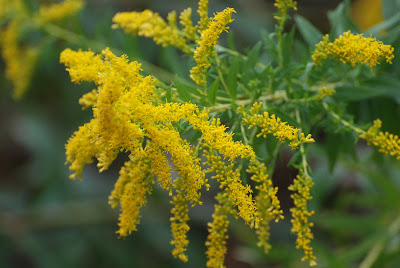A misunderstood wildflower
Do you ever feel misunderstood? Sometimes I do. And, I think there are many plants in this world that are not as appreciated as they should be. Take for example, Goldenrod (Solidago). It is often blamed as a chief cause of hay fever when in fact its pollen is too heavy to travel very far to be a significant producer of allergies. Seasonal allergies are usually caused by ragweed which blooms at the same time.
Goldenrod is in fact a member of the sunflower family (Asteraceae). It gets its name from two Latin words - solidus- and -agere- which mean to make strong or make healthy. Now, how can you go wrong with 'roots' like that?
Many Americans consider Goldenrod a weed while in Britain it is hard to find a garden without goldenrod. According to the Cambridge Dictionary the definition of a weed is

Goldenrod (Note: This plant also has the unusual ability to cross breed with other plants so it is very difficult to identify the exact species. There are over 130 species in the world some 90 in the United States alone.)
Driving through the countryside this week one of the brightest colors in and along the ditches right now is the Goldenrod. It starts to blooms just when most of the summer blooms have expired and the pollinators are still around searching for food. Well, Mother Nature provides in abundance. I have a solid color of yellow in the drainage ditch that runs along my backyard and it is a fountain of color and covered with pollinators!

Goldenrod with Common Buckeye

As is the case with many wildflowers, there is a medicinal value to these plants. Goldenrod has been used to treat sores and cuts, aliments such as kidney stones and urinary tract infections, tuberculosis, diabetes, asthma and arthritis.
Another highly beneficial quality of this plant is that it can also be used as a companion plant. It is host to some beneficial insects and repels some pests. How could any organic gardener turn their nose up at that?
With so many strong traits maybe this wildflower needs a second chance to prove itself as an essential plant in the American garden.
Goldenrod is in fact a member of the sunflower family (Asteraceae). It gets its name from two Latin words - solidus- and -agere- which mean to make strong or make healthy. Now, how can you go wrong with 'roots' like that?
Many Americans consider Goldenrod a weed while in Britain it is hard to find a garden without goldenrod. According to the Cambridge Dictionary the definition of a weed is
any wild plant that grows in an unwanted place, especially in a garden or field where it prevents the cultivated plants from growing freely.In fairness some species are invasive, such as Canada goldenrod (Salidago canadensis); but, there are many goldenrod that are more tame. One person's attractive plant can quite easily be another person's troublesome weed.

Goldenrod (Note: This plant also has the unusual ability to cross breed with other plants so it is very difficult to identify the exact species. There are over 130 species in the world some 90 in the United States alone.)
Driving through the countryside this week one of the brightest colors in and along the ditches right now is the Goldenrod. It starts to blooms just when most of the summer blooms have expired and the pollinators are still around searching for food. Well, Mother Nature provides in abundance. I have a solid color of yellow in the drainage ditch that runs along my backyard and it is a fountain of color and covered with pollinators!

Goldenrod with Common Buckeye

As is the case with many wildflowers, there is a medicinal value to these plants. Goldenrod has been used to treat sores and cuts, aliments such as kidney stones and urinary tract infections, tuberculosis, diabetes, asthma and arthritis.
Another highly beneficial quality of this plant is that it can also be used as a companion plant. It is host to some beneficial insects and repels some pests. How could any organic gardener turn their nose up at that?
With so many strong traits maybe this wildflower needs a second chance to prove itself as an essential plant in the American garden.
.png)
